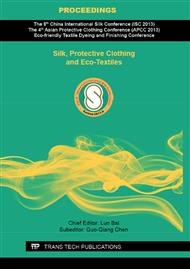p.607
p.613
p.617
p.623
p.630
p.634
p.639
p.643
p.649
Effect of Undergarments on Micro-Environment under Anti-Static Dust-Free Clothing
Abstract:
In this study, the effect of different undergarments on micro-climate environment under anti-static dust-free clothing was investigated. Five male undergraduates participated in wear trials conducted in a climate chamber of 24 ± 1°C and 60 ± 5%RH, three undergarments of different materials were worn under an antistatic dust-free overall respectively. While subjects doing mild exercise, the temperature and relative humidity under the undergarment was measured at chest, and the skin temperature at arm, chest, thigh and calf were measured. It was found that undergarment made of plain woven fabric was the best to keep the relative humidity on skin surface low and mean skin temperature stable during mild exercise among three undergarments of different materials. It was demonstrated that hydrophilic fiber might not the best material of undergarment for protective clothing, knitted fabrics which have more volume to hold water might not be good either. It was showed that materials absorb water and moisture and quick dry is suitable to undergarment for protective clothing.
Info:
Periodical:
Pages:
630-633
Citation:
Online since:
September 2013
Authors:
Price:
Сopyright:
© 2013 Trans Tech Publications Ltd. All Rights Reserved
Share:
Citation:


